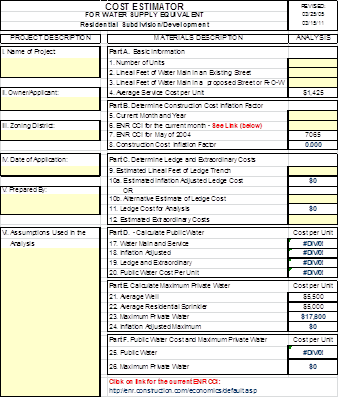Estimator for Water Supply Costs
Download - Estimator for Water Supply Costs
 Chapter II Section IX of the Gorham Land Use and Development Code requires that certain projects conduct an analysis to determine if the development needs to be serviced by public water. This paper sets out the process to be used in conducting that analysis.
Chapter II Section IX of the Gorham Land Use and Development Code requires that certain projects conduct an analysis to determine if the development needs to be serviced by public water. This paper sets out the process to be used in conducting that analysis.
Step 1:
Determine the Site Layout to be Used in the Analysis.
The Land Use and Development Code requires that the analysis of water supply be based on:
- The proposed development scenario if the entire lot will be developed or subdivided and there is no potential for future development, or;
A full build-out scenario if the Planning Board requires it or if only a portion of the site is proposed to be developed. The full build-out scenario is be based on the development of the site and is based on the allowed zoning density with public water taking into account site constraints and Town regulations. Planning Board approval is required.
Therefore, the applicant should meet with the Town Planner prior to conducting the analysis to review the proposed development scenario to be used. If the density of the proposed development scenario is significantly less than that allowed by zoning, or if only a portion of the site is proposed to be developed, or if there will be potential for additional future development, the Town Planner will require that the applicant prepare a full build-out scenario to be used in the analysis. The Planner shall refer this scenario to the Planning Board for its approval. The Planning Board shall approve the scenario for the purpose of the water supply analysis if it finds that it represents a reasonable use of the land considering site conditions, the interest of the owner/applicant, and the Town’s regulations and will not bias the water supply analysis.
Step 2:
Determine the Public Water System Needed to Supply the Proposed Layout.
Once the development scenario to be used in the analysis has been approved by the Town Planner and Planning Board, the applicant shall determine the public water supply system needed to service the development scenario. This shall be done in conjunction with the Portland Water District. The District shall provide written documentation that it believes the proposed system is rationale to serve the development scenario.
The proposed public water supply system should be shown on the sketch plan of the development scenario submitted with the worksheet (see Step 3) together with any supporting documentation.
 Step 3:
Step 3:
Complete the following Cost Estimator Worksheet.
The final step in the analysis is to complete the worksheet comparing the Public Water Cost Per Unit with the Maximum Private Water Cost Per Unit in accordance with the formula set out in the Land Use and Development Code. The worksheet is set up as an Excel spreadsheet. If the appropriate variables are entered in the spreadsheet, it calculates both the public and private water supply costs.
Here are instructions for completing the worksheet:
The required information should be provided in the yellow boxes on the spreadsheet.
- Enter the number of dwelling units in the project. This should include any existing units that are part of the project that are not served by public water.
- Enter the number of lineal feet of water main that will need to be constructed in an existing street or road to serve the development. This should include only construction where existing pavement will need to be disturbed and replaced.
- Enter the number of lineal feet of water main that will need to be constructed in new streets or in rights-of-way that are outside of streets or roads. This should include all construction that will not involve disturbing existing pavement.
- This is a supplied cost – do not enter anything in this box.
- Enter the name of the project.
- Enter the name of the owner or applicant.
- Enter the zoning district in which the project is located. If it is located in more than one zone, enter all of the zones and attach a sketch showing what parts of the property are in which zones if that is not shown on the development scenario.
- Enter the date of submission of the analysis.
- Enter the month and year of the analysis.
- Enter the ENR (Engineering News Record) Construction Cost Index for the month of the analysis. The CCI can be obtained from the Town Planner or from the ENR website.
- This is a supplied figure – do not enter anything in this box.
- The worksheet will calculate the inflation factor based upon the information supplied – do not enter anything in this box.
- If the project will involve ledge trench due to shallow bedrock conditions, enter the estimated number of lineal feet of ledge trench. Attach the rational for your estimate to the printed worksheet when you submit it.
- The worksheet will calculate the estimated ledge cost based upon the data provided – do not enter anything in this box.
- You may also provide an alternate estimate of the cost of ledge removal to install the public water system. This is an option – you do not have to complete this box. If you prepare an alternate cost, enter the total ledge removal cost estimate in this box and attach the basis for the estimate to the printed worksheet you submit.
- The worksheet will select the greater of 14a or 14b to be used in the analysis and show it in this box – do not enter anything in this box.
- If the project will involve any extraordinary costs such as special provisions for crossing a stream or for pressure reduction or augmentation, enter the estimated cost for these provisions. Any special costs shall be included only if the Portland Water District verifies that the provisions are needed to serve the development scenario.
- (17-26) Based upon the information provided, the worksheet will calculate the balance of the data and display it in the appropriate boxes. Box 25 shows the Public Water Cost per Unit. Box 26 shows the Maximum Private Water Cost per Unit. If the public water cost per unit is less than the maximum private cost per unit, the Planning Board will require that public water be used to service the development.
